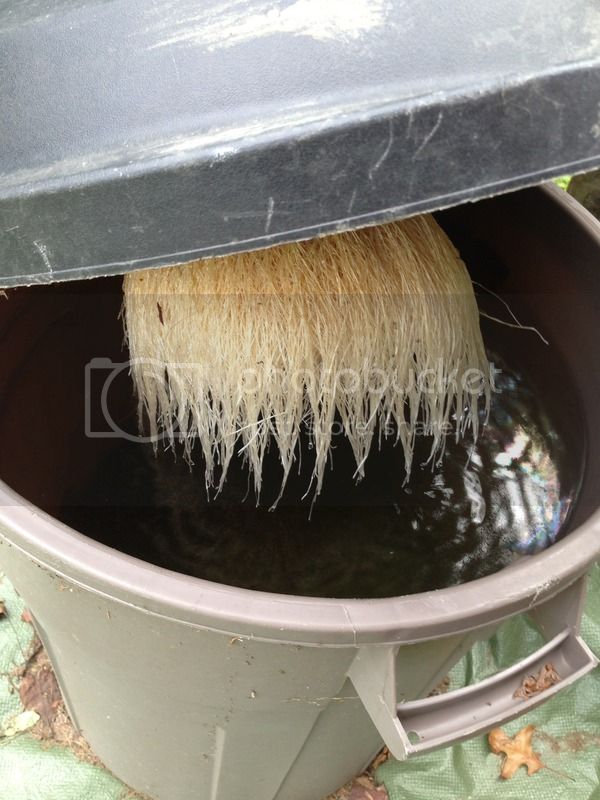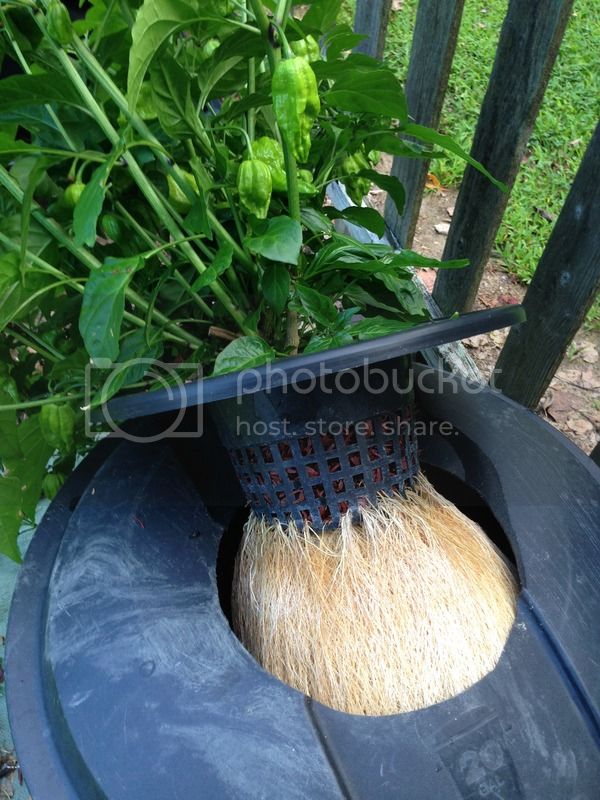After developing an interest in non-circulating, SNAP, and simplified hydroponics, I had opportunity to correspond with Professor B.A. Kratky of the University of Hawaii. He provided links to his research on hydroponics, including the use of fill-and-forget hydroponics. I had opportunity to test this fill-and-forget method with a Bhut Jolokia 'ghost' pepper.
Below is an overwintered Bhut Jolokia 'ghost' pepper that I bought from an area garden nursery center.

I rinsed the dirt off the roots and repotted into a bucket lid net pot. A hole was cut with a utility knife through the lid of a 20-gallon trash can, into which the net pot was inserted. The roots were surrounded with an inert media provided stability to the plant. The 20-gallon trash can was filled with water until the bottom of the roots were covered with about 0.25" of water, just barely touching the water. Dyna Gro Grow 7-9-5 hydroponic fertilizer was added at 1 teaspoon per gallon, along with some Epsom salt at one teaspoon for every 5 gallons of water. The mixture was stirred. As the plant grew, the roots began growing as seen below. The root length stay at the nutrient level in balance as the nutrient drops and roots grow longer.


Below you can see the root mass has increased greatly.

The Bhut Jolokia 'ghost' pepper has correspondingly grown huge and is loaded with peppers.


By the time the nutrient is used up, an entire harvest of peppers will have been completed. The plant can be cloned or discarded, and the trash can and net pot rinsed off with a garden hose until next season.
https://www.youtube.com/watch?v=6LTq3WKxYV0
Below is an overwintered Bhut Jolokia 'ghost' pepper that I bought from an area garden nursery center.

I rinsed the dirt off the roots and repotted into a bucket lid net pot. A hole was cut with a utility knife through the lid of a 20-gallon trash can, into which the net pot was inserted. The roots were surrounded with an inert media provided stability to the plant. The 20-gallon trash can was filled with water until the bottom of the roots were covered with about 0.25" of water, just barely touching the water. Dyna Gro Grow 7-9-5 hydroponic fertilizer was added at 1 teaspoon per gallon, along with some Epsom salt at one teaspoon for every 5 gallons of water. The mixture was stirred. As the plant grew, the roots began growing as seen below. The root length stay at the nutrient level in balance as the nutrient drops and roots grow longer.


Below you can see the root mass has increased greatly.

The Bhut Jolokia 'ghost' pepper has correspondingly grown huge and is loaded with peppers.


By the time the nutrient is used up, an entire harvest of peppers will have been completed. The plant can be cloned or discarded, and the trash can and net pot rinsed off with a garden hose until next season.
https://www.youtube.com/watch?v=6LTq3WKxYV0
